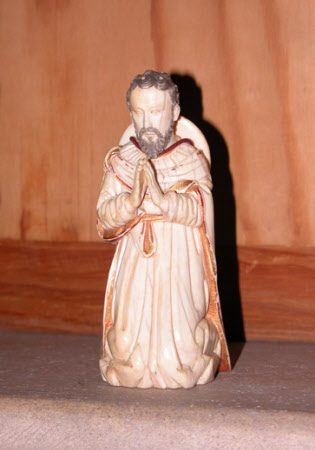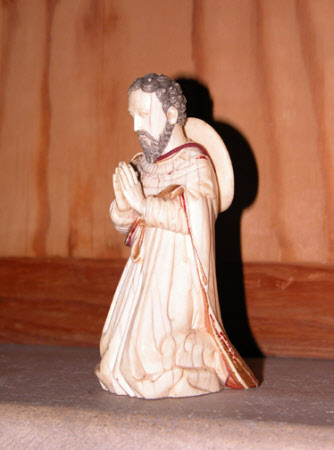Saint Joseph, from a Nativity group
Sri Lankan
Category
Art / Sculpture
Date
c. 1600 - 1700
Materials
Ivory
Measurements
120 x 50 x 68 mm
Place of origin
Sri Lanka
Order this imageCollection
Anglesey Abbey, Cambridgeshire
NT 517647
Summary
Ivory; Saint Joseph; Sri Lanka; c. 1600-1700. A Singalese (Sri Lankan) figure in elephant ivory of a holy figure kneeling in prayer, probably Saint Joseph from a Nativity scene. The heavily robed figure is partly gilded and painted, the inside and outer edges of the cloak gilded, Joseph’s hair and beard painted brown. Fitted with a separately made pilgrim’s hat, which may be original to the object and, if so, is a rare survival.
Full description
This small figure is an excellent example of Indo-Portuguese ivory carving, a class of sculpture that developed with the expansion of the Portuguese commercial and maritime empire into the Indian subcontinent and further east in Asia in the sixteenth century. Along with the merchants came large numbers of missionaries who established churches and schools, with the aim of converting the local inhabitants. Ivory carving had been a long-established tradition throughout much of the Indian subcontinent. The Jesuits were especially active in encouraging indigenous craftsmen to work on Christian subjects, often using prints imported from Europe as models. The great majority of Indo-Portuguese ivories are therefore Christian in subject matter, but these sculptures often reflect local religious traditions too. The best example of this practice is the figures of the seated Christ as the Good Shepherd, in which a Buddha-like figure of Christ is placed upon a mountain-type structure (example at Tyntesfield, NT 15668). As well as being used locally, Indo-Portuguese carvings were also exported to Europe in large numbers. The earliest and highest-quality carvings were made on the island of Ceylon (Sri Lanka), but the biggest centre of production was Goa, the principal Portuguese base on the Subcontinent. Ivories were also produced by Chinese craftsmen working in the Portuguese colony of Macao and in the Spanish Philippines. This kneeling figure would appear to be a representation of Saint Joseph kneeling before the crib, as part of a scene of the Nativity. This identification is not definitive, since it is difficult to find other strictly comparable figures. As a kneeling figure in prayer, the sculpture is in fact closest compositionally to a tiny figure of Christ praying during his Agony in the Garden, on the night before he was crucified. It is one of a series of figures of Christ featuring different stages of the Saviour’s Passion, that are found placed in niches in the base of seventeenth-century Indo-Portuguese small Calvary altarpieces (for examples of these figures, see Bernardo Ferrão de Tavares e Távora, Imaginária Luso-Oriental, Lisbon 1983, pp. 104-05, fig. 137). Most Indo-Portuguese carvings of Saint Joseph, on the other hand, depict the saint standing, often as part of a group in which the Virgin and Joseph hold the hands of the Christ Child, also standing and portrayed as a young boy (Margarita M. Estella Marcos, La Escultura Barroca de Marfil en España. Las escuelas europeas y la colonials, 2 vols., Madrid 1984, nos. 673-705, figs. 293-300). These groups often show Joseph with a hat and a staff, referring to the flight of the Holy Family into Egypt. The presence in the Anglesey Abbey figure of a separately carved hat is therefore helpful to the notion that he might indeed be identifiable as Joseph. The ivory of the hat seems consistent in colour and texture with the main figure, so it may well be original to the sculpture and, as such, is an extremely rare survival. Nativity groups could be very elaborate with numerous figures, but not many survive complete. In one seventeenth-century example, formerly in the Manuel de Sousa Oliveira collection in Oporto, the figures are made of wood and ivory; in this group, Saint Joseph is seen kneeling before the crib, but with a staff in his hand rather than in prayer (Imaginária Luso-Oriental, p. 59). In most of the Nativity multiple figure groups, Joseph is depicted holding a staff and with his right hand clasped to his chest (e.g. Estella Marcos, La Escultura Barroca de Marfil en España, no. 706, fig. 303; Margarita Mercedes Estella Marcos, Ivories from the Far Eastern Provinces of Spain and Portugal, Monterrey 1997, pp. 264-65, cats. 152-53). In a Saint Joseph in the British Museum, made in Goa or Manila in the seventeenth century, he kneels on one knee, his right hand raised in blessing whilst his missing left hand probably held a staff (Inv. 1881,0913.4. O.M. Dalton, Catalogue of the Ivory Carvings of the Christian Era with Examples of Mohammedan Art and Carvings in Bone in the Department of British and Mediaeval Antiquities and Ethnography of the British Museum, London 1909, p. 169, no. 554, Pl. CXXII). A similar figure was exhibited at the Burlington Fine Arts Club in 1923 (Catalogue of an Exhibition of Carvings in Ivory, London 1923, p. 105, no. 214. Sold at Sotheby’s on 11 November 1926, Burlington Magazine, November 1926, p. xix). When compared to many Portuguese Asian carvings, for example two kneeling figures of Saints Dominic and Francis in a private collection (Beatriz Sanchez Navarro de Pintado, Marfiles Cristianos del Oriente en Mexico, Mexico 1985, Fig. 16), the Anglesey Abbey Saint Joseph is of high quality. This would help to suggest an origin in the island of Ceylon (today's Sri Lanka), where the finest carvings were made. A stylistic feature that might also support a Sri Lankan origin is Saint Joseph’s hair, worked into tight curls that end in a bead. This treatment, which is characteristic of ivory carving in Sri Lanka, may be seen in two Singhalo-Portuguese figures of the standing Christ as Saviour of the World, dated to the seventeenth century, in a Mexican private collection (Estella Marcos 1997, p. 243, cat. 129; p. 244, cat. 131). It is also to be seen in similar Singalese figures in the Osvaldo Gil Matias collection (Osvaldo Gil Matias, Marfins das Províncias Orientais de Portugal e Espanha no Brasil, Rio de Janeiro 2013, p. 167, no. 133; p. 172, no. 138). Jeremy Warren October 2021
Provenance
Urban Huttleston Rogers Broughton, 1st Lord Fairhaven (1896-1966), by whom bequeathed in 1966.
Makers and roles
Sri Lankan , sculptor Goanese School, sculptor

